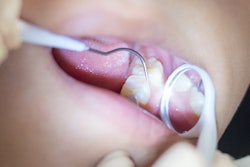
A goal of minimally invasive dentistry is to restore carious tissue. Researchers tested a novel restorative material and two others to see if they promoted the remineralization of carious lesions.
They conducted an in vitro study to measure the fluoride ion release rates from a glass ionomer cement, a novel hydrophilic resin-modified glass ionomer cement, and a nanohybrid restorative polymer resin. The glass ionomer cement had the highest release rate, they reported in Advances in Clinical and Experimental Medicine (February 8, 2019).
The fluoride ion release profile of the hydrophilic resin-modified glass ionomer cement was lower than the glass ionomer cement but significantly higher than the nanohybrid restorative polymer resin, wrote the authors, led by Alicja Porenczuk, PhD, DDS, of the restorative dentistry department at Warsaw Medical University in Poland.
Tissue remineralization
Remineralizing carious tissue is a focus of current clinical treatment. The remineralization process entails adding fluoride, calcium, and phosphate ions into demineralized tissues in the teeth. New bioglass-reinforced materials capable of releasing these ions may be useful in the tissue remineralization process.
The researchers wanted to compare one of these novel materials with two established materials to see which released the most fluoride ions in an in vitro test. The novel material was Activa BioActive-Restorative (Pulpdent), a hydrophilic resin-modified glass ionomer cement enriched with bioglass particles and fortified with a patented rubberized polymer resin. The two established materials were the glass ionomer cement Ketac Molar Quick Aplicap (3M) and the nanohybrid restorative polymer resin, Tetric EvoCeram (Ivoclar Vivadent).
The researchers prepared 15 disk-shaped specimens for each of the three materials. They applied the materials to 3D molds and then light-cured them. After setting, the specimens were freed from the forms polished with silicone carbide paper of varying grits, acid-etched for 60 seconds with 38% phosphoric acid, rinsed with water, and blow-dried with air. The researchers weighed the specimens and then incubated them for two weeks in deionized water.
The team measured the fluoride ion release profiles using a fluoride-specific electrode.
The greatest quantity of fluoride ions was freed from the Ketac Molar Quick Aplicap (from 20.698 ppm to 54.118 ppm), followed by the Activa BioActive-Restorative (1.236 ppm to 15.552 ppm) and Tetric EvoCeram (0.370 ppm to 1.148 ppm), the researchers found. The highest quantity of the fluoride ions was released in the first four days, they noted.
"In our study, the bioglass-reinforced [resin-modified glass ionomer cement] obtained the highest level of freed fluoride ions on the first day (15.5 ppm), which later decreased to a continuous plateau of 1.2 to 3.0 ppm," they wrote.
No specific recommendations
The authors noted that this was an in-vitro study and made no treatment recommendations in the study.
However, they concluded that the fluoride ion release profile of Activa was lower than the glass ionomer cement Keta Molar Quick Aplicap but significantly higher than the nanohybrid restorative polymer resin Tetric EvoCeram.
"The release of fluoride ions from [glass ionomer cements] takes place during their maturation and is diffusion-controlled, meaning that it declines in a linear fashion, reaching a plateau within 10 to 20 days," the authors wrote.



















